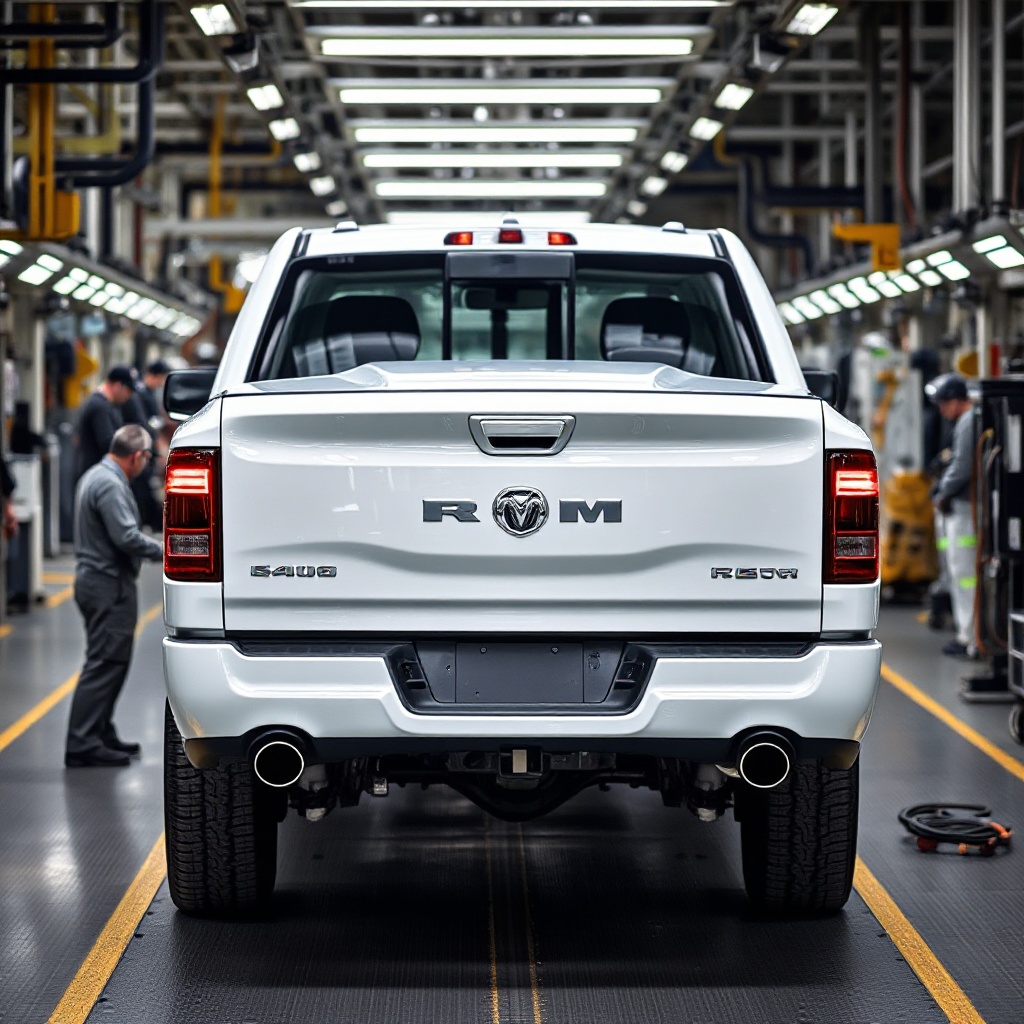
Stellantis delays Ram electric trucks as industry recalibrates amid disappointing EV pickup sales, revealing tension between electrification goals and market realities.

Drivetech Partners
Stellantis has repeatedly pushed back the launch of its electric Ram trucks, reflecting a broader recalibration happening throughout the automotive industry as electric pickup sales fall significantly short of projections. This ongoing adjustment of timeline expectations—with the Ram 1500 REV now delayed until model year 2028 and the Ramcharger until 2026—signals a fundamental shift in how legacy automakers are approaching the complex balance between ambitious electrification goals and market realities.
Key Takeaways
Stellantis has delayed the Ram 1500 REV by nearly three years, now targeting a 2028 model year launch amid slowing electric truck demand
Unlike competitors, Stellantis is pursuing a flexible manufacturing strategy that allows production of gas, hybrid, and electric trucks on the same assembly line
Electric pickup sales across all brands—including Ford's F-150 Lightning and Tesla's Cybertruck—have fallen short of expectations
Ram has scaled back initial promises on range and towing capacity for the 1500 REV as engineering and market realities set in
The delays reflect a broader industry recalibration as automakers adjust their aggressive EV timelines to match actual consumer demand
Ram Electric Vehicles: From Ambitious Plans to Multi-Year Delays
What began as a bold vision for Stellantis' electric truck lineup has transformed into a series of significant timeline adjustments. The Ram 1500 REV, originally scheduled for a 2024 launch as a 2025 model, has now been pushed all the way to summer 2027 as a 2028 model-year vehicle. Similarly, the Ramcharger range-extended pickup has shifted from its initial 2025 target to the first quarter of 2026 at the earliest.
These represent the second major postponements for both models, effectively adding three years to the company's initial targets. Despite these delays, Stellantis has demonstrated its long-term commitment to electrification by investing $235.5 million into its Sterling Heights Assembly facility to enhance production flexibility for various powertrain types.

Market Reality Check: Electric Pickup Demand Falls Short
The primary driver behind these delays is what Stellantis describes as "slower-than-expected demand for half-ton battery-powered pickups." This challenge isn't unique to Ram—Ford's F-150 Lightning, GM's Silverado EV and Sierra EV, and Tesla's Cybertruck have all experienced sales volumes that fall notably short of projected targets.
Even Tesla, often considered the EV market leader, is reportedly holding significant unsold Cybertruck inventory. Adding to these market challenges is the changing U.S. political landscape, which has created substantial uncertainty around the future of EV incentives and emissions standards—key factors in consumer purchase decisions.
The evidence points to a clear mismatch between automakers' ambitious production capacity investments and actual consumer adoption rates for electric pickups. This gap has forced companies across the industry to reevaluate their approach to the segment.
Strategic Pivot: Flexible Manufacturing vs. Dedicated EV Plants
In response to these market challenges, Stellantis has adopted a "production flexibility" approach that differs significantly from some competitors. This strategy enables the manufacturer to produce gasoline, hybrid, and electric Ram 1500 variants from a single plant, allowing production volumes to shift based on actual customer demand.

This approach stands in stark contrast to the strategies employed by Ford and GM, which have dedicated entire factories exclusively to EV production. While dedicated facilities can optimize electric vehicle manufacturing, they also create significant financial pressure when demand fails to materialize as expected.
Stellantis has also cited an extended "quality validation period" for the Ramcharger as an additional factor in its timeline adjustments. This suggests the company is taking extra time to ensure its hybrid powertrain technology meets reliability expectations—especially important for pickup truck buyers who often use their vehicles in demanding work environments.
Product Compromises: Scaling Back Promised Capabilities
As development progressed, Ram has been forced to scale back several ambitious promises for its electric lineup. The Ram 1500 REV's original claims of 500-mile range have been reduced to approximately 350 miles, while the initially promoted 14,000-pound towing capacity has also seen downward revisions.
Some planned features, like the fold-down midgate that would have extended cargo capacity into the cabin, have been eliminated from the final design. Meanwhile, the Ramcharger will offer about 145 miles of electric-only range with its onboard gasoline generator providing extended range for longer trips—positioning it as a compromise solution for buyers interested in electrification but concerned about range limitations.
These changes reveal the technical and financial challenges of delivering on early EV promises, as well as the ongoing supplier frustration as repeated delays affect tooling and component investments throughout the supply chain.
Financial Pressures Mounting on Legacy Automakers
Legacy manufacturers like Stellantis face substantial financial strain as they attempt to balance investments in electric and traditional offerings. The scale of investment required is staggering—Ford has committed $50 billion to EVs by 2026, while GM plans to spend $35 billion between 2020-2025, plus an additional $850 million in recent allocations.
This stands in contrast to startups like Rivian, which raised $13.7 billion in its 2021 IPO alone—capital exclusively focused on electric vehicles without the burden of supporting existing product lines. The investment gap highlights the different financial realities faced by established automakers versus new entrants.
Complex supply chain challenges for batteries and semiconductors further complicate production planning, as securing these critical components requires long-term commitments that may not align with shifting market demand.
Competition Intensifies: New Entrants vs. Established Players
The competitive landscape has grown increasingly challenging as Chinese NEV startups and new market entrants have moved faster in securing critical supply chains. These newer competitors can often operate with greater agility, placing pressure on legacy brands in terms of both pricing and technology innovation.
Established automakers face the additional burden of defending existing market share while managing complex capital allocation decisions. Unlike startups, they cannot focus exclusively on electric vehicles without risking their core business.
This creates a strategic dilemma: move too quickly toward electrification and risk financially overextending; move too slowly and risk losing market position to more agile competitors. For Stellantis, the Ram delays represent an attempt to find this delicate balance.
Industry Reset: Electric Pickup Future Takes New Shape
The electric pickup market is expected to remain volatile as consumer demand continues to evolve unpredictably. In response, automakers are increasingly pivoting toward mixed powertrain lineups rather than pursuing aggressive all-in EV strategies.
Careful capital allocation has become a priority over rapid EV deployment, with success factors now defined by product adjustments, investment in flexible assembly, and supply chain resilience. This represents a more measured, market-responsive approach to electrification.
The Ram delays are part of a broader industry recalibration that acknowledges the gap between initial electric pickup enthusiasm and actual adoption rates. While the electric future for trucks remains certain in the long term, the path to get there is proving more evolutionary than revolutionary.
Sources: Mopar Insiders - Ram Delays 1500, Ramcharger, and REV Pickups Again, GM Authority - Stellantis Further Delays Ram 1500 REV, Ramcharger Pickups, Kelley Blue Book - Ram Delays Electric Truck Again, The Drive - Ram Announced an EV in 2021, It's Been Delayed Again Until the 2028 Model Year, Automotive News - Stellantis Delays EV Pickup, Caresoft Global - Challenges Facing Legacy Automakers: The Rise of New Energy Vehicle Startups






